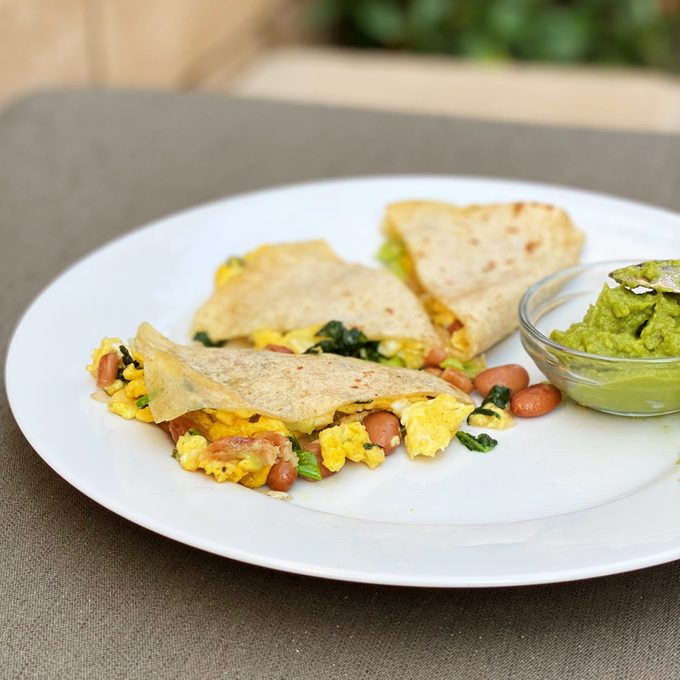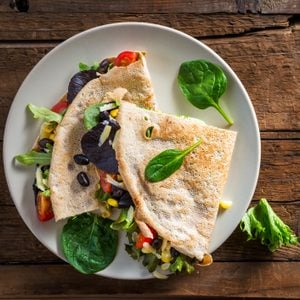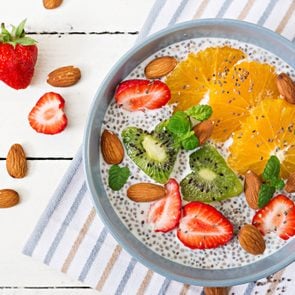How to Make a Healthy Breakfast Quesadilla, According to Registered Dietitians
Updated: Mar. 16, 2022
Breakfast quesadillas are the ultimate comfort food, but they aren't always the healthiest. Use these expert tips to create a healthy one.
Our editors and experts handpick every product we feature. We may earn a commission from your purchases.
Quesadilla for breakfast
If you’ve fallen into a breakfast rut, it’s time to mix things up with a super tasty and healthy breakfast quesadilla. This trendy twist on a classic Mexican comfort food usually works in some eggs and beans for filling protein.
You can create your own version based on tips from my registered dietitian colleagues. If you want step-by-step instructions, check out my healthy breakfast quesadilla recipe for the perfect example of a tasty and nutrient-packed breakfast quesadilla.
Reasons to love breakfast quesadillas
From their nutritious content to their convenience, there are so many reasons to make quesadillas for your morning meal.
They’re customizable
Do you want your breakfast quesadilla to be spicy or mild? Savory or spicy? Meaty or plant-based? It’s all up to you. As long as you start with a tortilla, fill it, flatten it and cook it, it’s still a breakfast quesadilla.
They’re easy to make
Mornings can be hectic enough, so there’s no need to add a complicated breakfast recipe. Quesadillas are super easy to make and quick to prep and cook. You can also wrap them up in foil or place them into an airtight container so you can have breakfast on the go.
Get more whole grains, protein, and vegetables in your day
Breakfast quesadillas are a great way to get energizing carbs, filling fiber, muscle-building protein, and nutrient-packed vegetables into your morning.
They can help you make healthier choices beyond breakfast
Eating well earlier in the day helps you make better choices later. The reason? You won’t be ravenously hungry so you’ll be better equipped to turn down less healthy temptations and stick to your healthy eating goals. Plus, there’s something about starting your day off right that helps with motivation. You’re already on the right track, so why veer off now.
Cheese
At breakfast. Enough said.
Should you eat breakfast every day?
“Eating breakfast helps with improved concentration, alertness, endurance, and mood,” says Tejal Pathak, MS, RD, a certified diabetes care and education specialist in Texas.
Plus, a small 2016 study of college students, published in the European Journal of Nutrition, found those who ate breakfast reported being happier than people who skipped it.
Breakfast eaters might also have a lower risk of heart disease, based on the results of a study of male health professionals in the U.S, published in Circulation.
Having a filling breakfast—especially one that includes protein—could also lead to better blood sugar control, suggests a February study in The Journal of Clinical Endocrinology & Metabolism. That’s important not only for people with diabetes, but keeping blood sugar from spiking and dropping can help all of us avoid getting hungry quickly and overeating or giving in to cravings.
Does eating breakfast promote weight loss?
There is plenty of research examining this question, but there isn’t a definitive answer.
A 2019 study published in the BMJ looked at 13 randomized control trials on eating breakfast and weight loss and found data is limited and each study was designed differently. This makes it difficult to come to a conclusion about whether breakfast helps with weight loss.
However, what researchers know is that skipping breakfast can lead to being hungrier and eating more at lunch. Plus, eating a bigger breakfast could help you burn 2.5 times more calories than eating the same amount at dinner, according to a March study in The Journal of Clinical Endocrinology & Metabolism.
Even if eating breakfast may not lead to losing weight, it hasn’t been shown to lead to weight gain. So to my fellow breakfast lovers, let’s dig in.
Key ingredients for a healthy breakfast quesadilla

I talked to some of my registered dietitian friends about their tips to make healthy breakfast quesadillas. Here are their recommendations on how to build extra nutrition into your morning meal, starting from the bottom and working our way up.
The tortilla
Making a healthy quesadilla all starts with choosing a healthy tortilla as your base.
Jessica Levinson, RDN, in Westchester, New York, uses corn tortillas, which many people don’t realize is whole grain. You can also try 100 percent whole wheat tortillas. Just be sure to check the ingredients list and make sure that it’s all whole wheat flour and no refined or white flour is listed.
Other whole grain tortilla options that are also gluten-free include those made from brown rice flour, quinoa, and millet. Choosing a whole grain tortilla over one made with refined white flour means you’ll be getting more fiber into your day. A shocking 95 percent of Americans don’t get enough fiber.
(Corn vs. flour tortillas: here’s what to consider when choosing.)
Eating a diet that’s rich in fiber has many health benefits. It helps prevent constipation and diverticulitis. Plus, getting enough fiber may help reduce your risk of chronic diseases such as type 2 diabetes, heart disease, and colorectal cancer.
If you’re making breakfast quesadillas for more than one person, Levinson suggests setting up a quesadilla “bar” so everyone can add his or her own fillings.
The filling
This is where you can really let loose and let your imagination run wild! Include a source of protein, vegetables, and heart-healthy fat and you’ll have a nutritious and delicious quesadilla on your hands (and in your hands, you lucky thing you)!
Protein
Getting enough protein at each of your meals—including breakfast—can help prevent you from getting hungry too soon. Protein is more filling than fat or carbohydrates, mainly because it influences hormones that signal to your brain that you’re full. Protein also supports muscle growth and maintenance as well as the healing and repair of all of your body’s tissues. As if that weren’t enough, protein also helps your body fight infection.
Eggs
Melissa Nieves, RD, in Puerto Rico and founder of the Fad Free Nutrition Blog, likes to make an omelet first and then presses it between two tortillas. “Eggs are a great source of protein and antioxidants lutein and zeaxanthin,” she says.
Levinson likes to start with a base of scrambled eggs, which she points out are “an excellent source of high-quality protein, choline, and vitamin A.”
If you’re trying to cut down on calories, fat, saturated fat, or cholesterol, you may have heard that egg whites are healthier than the yolks. I recommend you keep at least one of the yolks in your eggs, because that’s where many of the nutrients are concentrated—including about half of the protein.
Cheese
Marie Dittmer, RDN, founder of Healthy Ideas Place, skips the eggs in her breakfast quesadilla and uses cheese as her protein source. “Cheese is also a great source of calcium and other bone-building nutrients,” she explains.
Nieves doesn’t add any cheese during cooking but sprinkles her breakfast quesadilla with a bit of cheese after it’s cooked. This can help keep portion size, calories, and saturated fat in check.
My top tip is to lighten up on the cheese include choosing sharp or spicy cheese for the most flavor (that way you can use a bit less) or opting for lighter options such as part-skim mozzarella.
If you’re lactose intolerant, vegan, or otherwise want to avoid cheese, there are some great plant-based cheese substitutes out there that melt well and taste amazing.
Beans
Beans are a healthy choice for so many reasons. They contain four times as much fiber as brown rice and are a good source of plant-based protein. Plus, beans contain prebiotic fiber which fuels the healthy bacteria in your gut. Prebiotics can help with digestive health and may support a healthy immune system.
Whether you choose to add black beans or pinto beans, you’ll be getting health benefits. (Learn the nutritional value of the different types of beans.)
You can pre-soak and then cook dried beans, or if you’re short on time, use canned beans. Make sure you drain and rinse the beans well to get most of the salt off of them before using.
Pathak shares, “I make homemade refried beans with pinto or black beans, hemp seeds, garlic, and a touch of mint. I use that base for my quesadilla. It’s packed with protein, fiber, omega-3s, and complex carbohydrates.”
A great time-saving tip from Washington State-based registered dietitian Shena Jaramillo of Peace and Nutrition, is to use leftover vegan chili as a filler. “It saves the scraps and gives you tons of veggies and protein to kick start your day,” she says.
You can also use beef or turkey chili in your quesadilla. Just make sure to drain any excess water out of your chili and pat dry with some paper towels. This will help prevent your tortilla from getting soggy.
Vegetables
Nieves uses onions, peppers, and spinach in her breakfast quesadilla. “The onions are a good source of flavonoid antioxidants, peppers provide vitamin C, and spinach is high in vitamins A, K, and C, folate, calcium and iron,” she says.
Dittmer also adds mushrooms and tomatoes and explains why: “Tomatoes are a great source of the heart-healthy antioxidant lycopene, and along with the peppers, provide a source of Vitamin C. Mushrooms are rich in B vitamins and minerals; and spinach provides all kinds of nutrients, like Vitamins K, A, C, and folate.”
You can also get the benefit of tomatoes by adding your own salsa or pico de gallo. If you’re buying store-bought, look for lower sodium options with no added sugar.
Healthy fats
If you’re shying away from including healthy fats in your diet, it’s time to rethink that. The Dietary Guidelines for Americans state that replacing saturated fats (such as butter) with unsaturated fats (such as avocado) can help lower unhealthy LDL (low-density lipoprotein) cholesterol in your blood, which may reduce your risk of stroke and heart disease.
Dittmer spreads her tortilla with fresh avocado first and then adds her other fillings. You can also use avocado or guacamole as a topping or dip after you’ve loaded it up and cooked it.
One of my favorite time-saving tips that also saves on waste is that if you’re making a breakfast quesadilla for just one person, use single-serve cups like Wholly Guacamole Minis. That way you aren’t using only part of the avocado and letting the rest get brown before you use it.
Sweet twists
Try your breakfast quesadilla with a hint of sweetness.
Pathak serves her breakfast quesadillas with Greek yogurt and cranberries for a sweet twist. Colleen Christensen, RD in Grand Rapids, Michigan, and founder of No Food Rules, loves adding some sweeter salsa like mango or pineapple to help satisfy her morning sweet tooth.
I’ve made almond butter and banana breakfast quesadillas with a sprinkle of cocoa powder and coconut flakes. It reminds me of a healthier spin on a sweet crepe.
How to cook a healthy quesadilla
Microwave
Using the microwave to cook your breakfast quesadilla is the quickest way to get it on your table. It’ll be soft and fluffy but also possibly a bit soggy—especially when you add in vegetables.
If you microwave it, you won’t get the crispness on the outside that gives your breakfast quesadilla a satisfying crunch when you bite into it.
To microwave your quesadilla, start with 20 seconds on high. Keep doing 10 more seconds until your cheese has melted.
Stovetop
The preferred cooking method for me and most of the other dietitians I talked to is on the stovetop using a skillet or frying pan.
This allows you to saute the veggies (or fruit if you’re making a sweeter option) so you can let some of the water evaporate and prevent your quesadilla from getting soggy. The pan will also help you crisp up the quesadilla so it’s nice and golden brown and crunchy on the outside. (These are the fruits and veggies to eat raw.)
To pan fry your quesadilla, start with cooking any fillings. Spray your skillet with nonstick cooking spray and heat your skillet over medium high. Saute until meat is browned and has reached a safe internal temperature. For veggies, cook until the water has come out of them and evaporated and they’re a nice golden brown.
To crisp up the quesadilla and melt the cheese, put it in a skillet to cook once it’s been filled. Do this with a clean, dry skillet (don’t add any cooking spray or oil) over medium high. Covering your skillet with a lid will help the cheese melt faster.
Be sure to check the underside of your quesadilla frequently to achieve a golden brown and avoid burning it.
Air fryer
Christensen likes to fill her tortilla and then crisp up the quesadilla in an air fryer. She recommends using toothpicks to hold your quesadilla together, spraying the air fryer basket with non-stick cooking spray, and then cooking at 370 degrees F for five minutes.
Next, read about the healthy breakfast mistakes to avoid.



